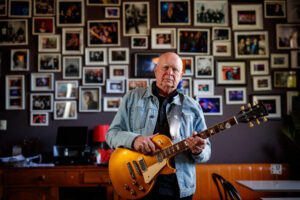The Carnival is Over: music festivals struggle as football roars
While the “not-for-profit” AFL has $5m to pay Katy Perry to play five songs at last weekend’s Grand Final, Australian music festivals are struggling.
It’s no secret that Australia’s music festivals are in crisis. In the past twelve months, major festivals, including Splendour in the Grass, Groovin’ The Moo, and Falls Festival have either folded or gone on hiatus. There are several reasons why these all-day (or all weekend) parties, which were once a summertime staple, are dropping like flies.
The first is that live music has struggled to recover from the COVID-19 pandemic lockdowns – about a third of Australia’s live music venues have closed since then. The live music scene is so dire that the Commonwealth government is holding an inquiry into what’s gone wrong.
A major survey of music festival organisers released earlier this year found that the most significant barrier to running a music festival is rising operational costs (fuel and electricity etc for lights, sounds, transport etc).
And then there is the impact of climate change – the increasing incidence of extreme weather has made hosting events harder and substantially increased the insurance costs.
Guess who ends up paying for all those bigger bills? Yep – festival goers.
The rise in cost over the past two decade has been such that what were once affordable festivals for students and younger workers are now expensive luxuries beyond the traditional audience.
Since 2005, the cost of a ticket to one of the major festivals has increased an average of 270%. Laneway tops the chart with a 527% increase, while Rainbow Spirit increased ‘just’ 132% – although that is not including price rises since 2020. To put this in perspective, between 2005 to 2023 overall inflation increased by 68%, and the average hourly wages have increased 75%.
These price rises have destroyed the affordability of attending festivals.
In 2005, a ticket to Splendour in the Grass cost $94 – which was still affordable for me as a 19 year old washing dishes at a seafood restaurant for $16 an hour.
In effect the cost was less than working a 6 hour shift.
By comparison the base rate for an entry level Woolworths employee working in October 2024 is $26.07, 19 year olds are paid the ‘junior rate’, which is about $20.86 per hour. At that rate, the price of a $324 ticket for this year’s (alas, cancelled) Splendour in the Grass would take over 15 hours to afford.
That’s more than twice as much time working to buy the same festival ticket.
Previous Australia Institute research showed that, for young Australians, the number one barrier to accessing live music is cost. And festival organisers know this only too well.
Peter Noble, the brains behind Bluesfest, has argued that it’s the RBA’s interest rate rises, which he notes “are created to curb discretionary spending, that are having an incredible effect on the music industry.” Although, as the Australia Institute has pointed out, the source of inflation isn’t discretionary spending.
But never fear – it’s not all bad in the entertainment industry – football is still… well… kicking goals.
In 2023 the AFL reported an operating surplus of $27.7 million, a $7 million increase from 2022. In the same year the NRL made over $700 million in revenue, and reported an operating surplus of $58 million.
The AFL and NRL of course have one big advantage over festival organisers – they don’t have to pay tax because as this year’s premiers explain, the AFL, NRL and all the member clubs are “not-for-profit” organisations. This because, as the ATO outlines organisations established for the purpose of encouragement of a game or sport, are exempt from income tax. The policy, which dates back to the 1930s, was intended to incentivise community organisations to provide facilities to encourage community participation in sports.
By that logic, Splendour in the Grass encourages community participation in music.
This is why, ironically, the AFL has so much money that it could afford to pay Katy Perry $5 million to play five songs at last weekend’s Grand Final. Sarah Hanson Young’s call for an Australian artist to play the big day so that they have a major platform during this time of crisis wasn’t successful, although Tina Arena did make an appearance.
In this regard the NRL is doing better. The entertainment at this weekend’s Grand Final is local hero and multiplatinum international star The Kid LAROI.
Not only do the major codes have money to attract acts that many festivals would envy, they’ve also managed to keep ticket prices relatively low. In contrast to what’s happened to the price of music festival tickets, the AFL has frozen prices for certain kinds of grand final tickets since 2019. And if you want to go to this weekend’s NRL grand final, you can pay as little as $55.
Hilariously, if the AFL was an organisation devoted to putting on a music festival on the last day of September it would have to pay tax. But having a sporting event at which Katy Perry gets $1m a song? Tax free!
Not all festivals are as big as those featured in this graph. In fact, of the 535 festivals held across Australia in the 2022-23 financial year, more than 40% were on the smaller side (meaning they had 1000 – 10,000 people).
The average cost to run a music festival in Australia is $3.9 million. While the Commonwealth Government has made noises about helping out the sector, the funding available can’t compete with the tax breaks and other grants given to the not-for-profit AFL and NRL.
In May’s federal budget, the Albanese committed $8.6 million to the ‘Revive Live’ program, which is intended to support live music venues and festivals.
This comes as festival organisers say that the second highest barrier to putting on a show is a lack of grants and funding, but it remains unclear how the money from Revive Live will be allocated, or if it will be enough to stem the tide of cancellations.
But that $8.6m pales in comparison to the benefits given to major football codes. On top of the tax concessions, in 2023 the AFL received over $100 million in government grants for the redevelopment of Marvel Stadium in Melbourne’s Docklands.
In contrast, a new grant program announced by Music Australia earlier this year was worth $1.45 million to support 98 projects. Or to put it in terms the AFL might understand – enough for about one-and-a-half Katy Perry songs.
Between the Lines Newsletter
The biggest stories and the best analysis from the team at the Australia Institute, delivered to your inbox every fortnight.
You might also like
Youth Cultural Passes Could Revive Australian Live Music Industry
With ticket prices rising and the ongoing cost-of-living crisis, a youth cultural pass could make live music more accessible, providing young people with opportunities to support local artists and foster a lifelong love of the arts.
Commonwealth live music inquiry: sing along with the chorus now…
The Australian Government’s latest report into the state of live music – “Am I Ever Gonna See You Live Again?” – makes some great recommendations, including for: tax offsets to be given to venues that host live music; training and education programs to help foster a love of music among young people; a rebate or
Highway to hell? Reversing the decline of Australian music
These days, Aussie music is falling out of the charts, leaving local acts wondering if they’ll ever see your face again.



